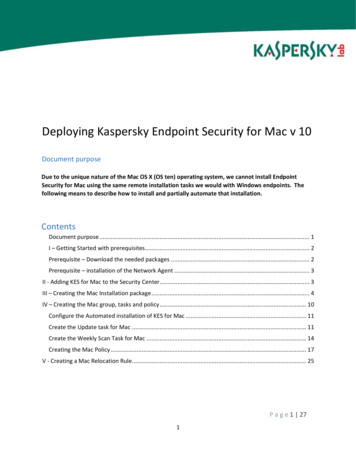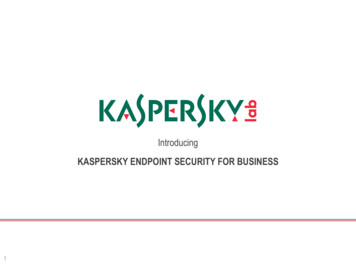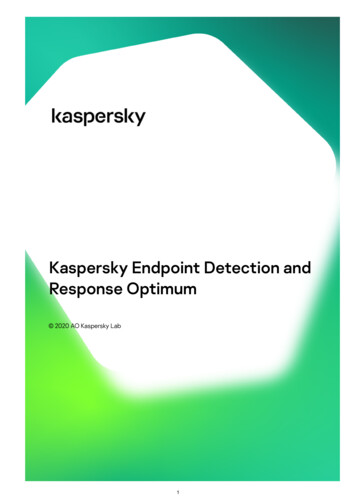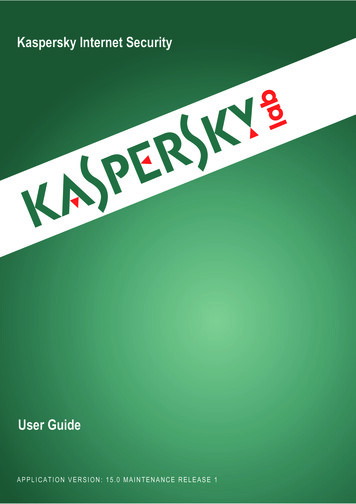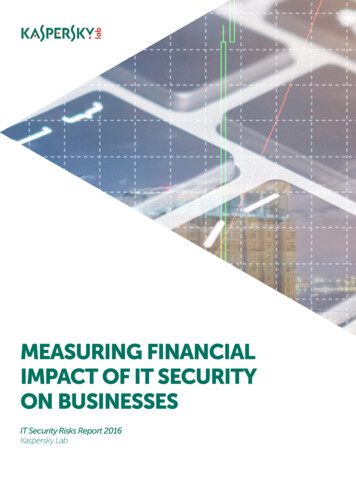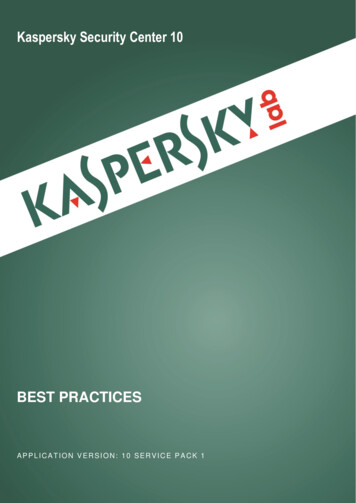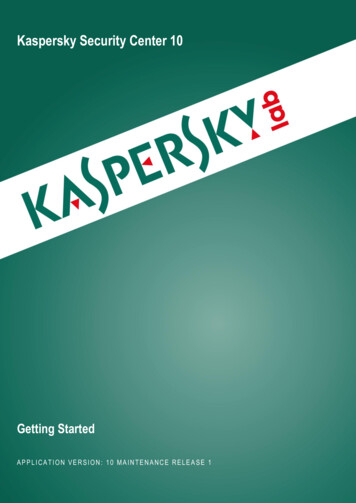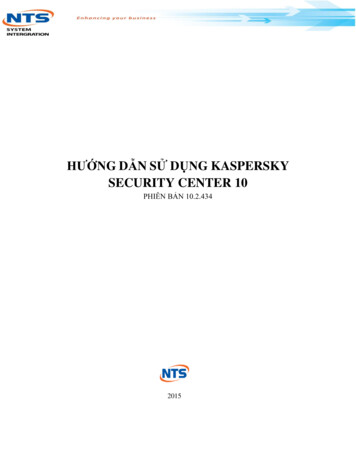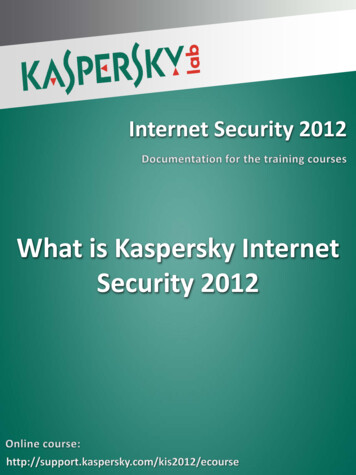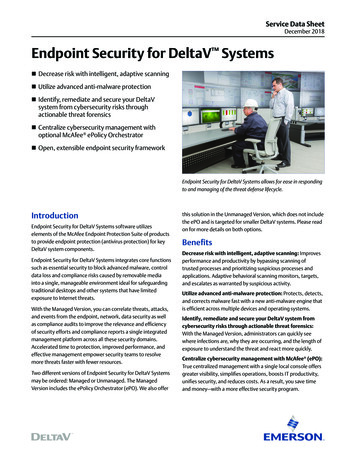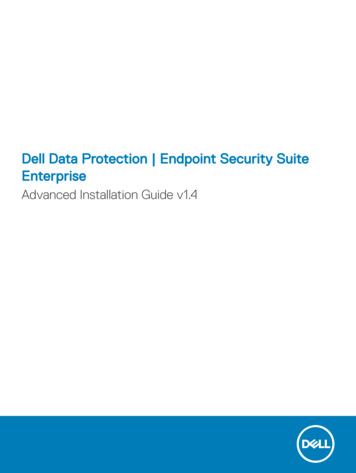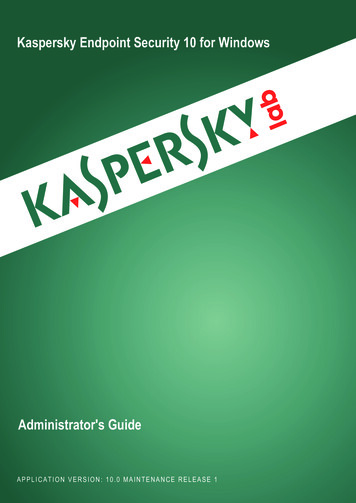
Transcription
Kaspersky Endpoint Security 10 for WindowsAdministrator's GuideAPPLICATION VERSION: 10.0 MAINTENANCE RELEASE 1
Dear User,Thank you for choosing our product! We hope that you will find this documentation useful and that it will provide answersto most questions that may arise.Warning: This document is the property of Kaspersky Lab ZAO (herein also referred to as Kaspersky Lab): all rights tothis document are reserved by the copyright laws of the Russian Federation and by international treaties. Illegalreproduction or distribution of this document or parts hereof will result in civil, administrative, or criminal liability underapplicable law.Any type of reproduction or distribution of any materials, including translations, may be allowed only with writtenpermission from Kaspersky Lab.This document and related graphic images can be used exclusively for informational, non-commercial, or personal use.This document may be amended without prior notice. The latest version of this document can be found on the KasperskyLab website, at http://www.kaspersky.com/docs.Kaspersky Lab assumes no liability for the content, quality, relevance, or accuracy of any third-party materials usedherein, or for any potential harm that may arise out of using such materials.Document revision date: 8/29/2013 2013 Kaspersky Lab ZAO. All Rights spersky.com2
CONTENTSABOUT THIS GUIDE . 11In this Guide . 11Document conventions . 13SOURCES OF INFORMATION ABOUT THE APPLICATION . 14Sources of information for independent research . 14Discussing Kaspersky Lab applications on the Forum . 14Contacting the Localization and Documentation Development Team . 14KASPERSKY ENDPOINT SECURITY 10 FOR WINDOWS . 15What's new . 15Distribution kit . 15Organizing computer protection . 16Hardware and software requirements . 18INSTALLING AND REMOVING THE APPLICATION . 19Installing the application . 19About ways to install the application . 19Installing the application by using the Setup Wizard . 20Installing the application from the command line . 23Installing the application using the Domain Group Policy Object Editor of Microsoft Windows Server . 25Description of setup.ini file settings . 26Initial Configuration Wizard . 29Installing the encryption module. 32Upgrading from a previous version of the application . 34About ways to upgrade an old application version . 34Upgrading a previous version of the application using the Domain Group Policy Object Editor of MicrosoftWindows Server . 35Removing the application . 36About ways to remove the application . 37Removing the application by using the Setup Wizard . 37Removing the application from the command line . 39Removing the application using the Domain Group Policy Object Editor of Microsoft Windows Server . 39Removing the encryption module . 39Removing objects and data remaining after test operation of Authentication Agent . 40APPLICATION INTERFACE . 41Application icon in the taskbar notification area . 41Application icon context menu . 42Main application window . 42Application settings window . 44APPLICATION LICENSING . 45About the End User License Agreement . 45About the license . 45About the activation code . 47About the key. 47About the key file . 47About data submission . 483
ADMINISTRATOR'S GUIDEAbout application activation methods . 48Licensing . 48Using the Activation Wizard to activate the application . 49Purchasing a license . 49Renewing a license . 49Viewing license information. 50Activation Wizard . 50STARTING AND STOPPING THE APPLICATION . 53Enabling and disabling automatic startup of the application . 53Starting and stopping the application manually . 53Pausing and resuming computer protection and control . 54PROTECTING THE COMPUTER FILE SYSTEM. FILE ANTI-VIRUS . 55About File Anti-Virus . 55Enabling and disabling File Anti-Virus . 55Automatically pausing File Anti-Virus . 56Configuring File Anti-Virus . 57Changing the file security level . 58Changing the File Anti-Virus action to take on infected files . 59Editing the protection scope of File Anti-Virus. 59Using Heuristic Analyzer with File Anti-Virus . 60Using scan technologies in the operation of File Anti-Virus . 61Optimizing file scanning . 61Scanning compound files . 62Changing the scan mode . 63SYSTEM WATCHER . 64About System Watcher . 64Enabling and disabling System Watcher . 64Using behavior stream signatures (BSS) . 65Rolling back malware actions during disinfection . 66EMAIL PROTECTION. MAIL ANTI-VIRUS . 67About Mail Anti-Virus . 67Enabling and disabling Mail Anti-Virus . 67Configuring Mail Anti-Virus . 68Changing the mail security level . 69Changing the action to take on infected email messages . 70Editing the protection scope of Mail Anti-Virus . 70Scanning compound files that are attached to email messages . 72Filtering attachments in email messages . 72Using heuristic analysis . 73Scanning emails in Microsoft Office Outlook . 73Scanning emails in The Bat! . 74COMPUTER PROTECTION ON THE INTERNET. WEB ANTI-VIRUS. 76About Web Anti-Virus . 76Enabling and disabling Web Anti-Virus . 76Configuring Web Anti-Virus . 77Changing the web traffic security level . 78Changing the action to take on malicious web traffic objects . 794
CONTENTSWeb Anti-Virus scanning of URLs against databases of malicious and phishing web addresses . 79Using Heuristic Analyzer with Web Anti-Virus . 80Configuring the duration of caching web traffic . 80Editing the list of trusted URLs . 81PROTECTION OF INSTANT MESSAGING CLIENT TRAFFIC. IM ANTI-VIRUS . 82About IM Anti-Virus . 82Enabling and disabling IM Anti-Virus . 82Configuring IM Anti-Virus . 83Creating the protection scope of IM Anti-Virus . 84Scanning URLs against databases of malicious and phishing URLs with IM Anti-Virus . 84Using Heuristic Analyzer with IM Anti-Virus . 85NETWORK PROTECTION . 86Firewall . 86About Firewall . 86Enabling or disabling Firewall . 87About network rules . 87About the network connection status . 88Changing the network connection status . 88Managing network packet rules . 89Managing network rules for application groups . 93Managing network rules for applications . 99Configuring advanced Firewall settings . 105Network Attack Blocker. 105About Network Attack Blocker. 106Enabling and disabling Network Attack Blocker . 106Editing the settings used in blocking an attacking computer . 107Monitoring network traffic. 107About network traffic monitoring . 108Configuring the settings of network traffic monitoring . 108Network Monitor . 111About Network Monitor .
Warning: This document is the property of Kaspersky Lab ZAO (herein also referred to as Kaspersky Lab): all rights to this document are reserved by the copyright laws
